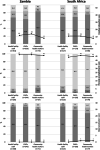Prevalence and risk of burnout among HIV service providers in South Africa and Zambia: findings from the HPTN 071 (PopART) trial
- PMID: 38978065
- PMCID: PMC11229271
- DOI: 10.1186/s12960-024-00934-9
Prevalence and risk of burnout among HIV service providers in South Africa and Zambia: findings from the HPTN 071 (PopART) trial
Abstract
Background: In the high disease burden and resource-constrained contexts of sub-Saharan Africa (SSA), health workers experience a range of psychosocial stressors that leave them vulnerable to developing burnout, which can reduce service quality and negatively impact their own health and wellbeing. As universal testing and treatment (UTT) for HIV scales up across SSA, we sought to understand the implications of this human resource-intensive approach to HIV prevention to inform decision-making about health workforce staffing and support needs.
Methods: Using the Maslach Burnout Inventory-Human Services Survey (MBI-HSS), we assessed the prevalence of three domains of burnout-emotional exhaustion, depersonalization, and personal accomplishment-among three cadres of health workers delivering health services in areas receiving a UTT intervention in Zambia and South Africa. These cadres included health facility workers (n = 478), community health workers (n = 159), and a study-specific cadre of community HIV care providers (n = 529). We used linear regression to assess risk factors associated with emotional exhaustion, the only domain with sufficient variation in our sample.
Results: The MBI-HSS was completed by 1499/2153 eligible participants (69.6% response rate). Less than 1% of health workers met Maslach's definition for burnout. All groups of health workers reported lower levels of emotional exhaustion than found in previous studies of this type (mean score scores ranged from 10.7 to 15.4 out of 54 across health cadres). Higher emotional exhaustion was associated with higher educational attainment (βadj = 2.24, 95% CI 0.76 to 3.72), greater years providing HIV services (βadj = 0.20, 95% CI 0.03 to 0.36), and testing negative for HIV at last HIV test (βadj = - 3.88 - 95% CI 5.69 to - 2.07). Working as a CHW was significantly associated with lower emotional exhaustion (βadj = - 2.52, 95% CI - 4.69 to - 0.35). Among all health workers, irrespective of HIV status, witnessing stigmatizing behaviors towards people living with HIV among their co-workers was associated with significantly increased emotional exhaustion (βadj = 3.38, 95% CI 1.99 to 4.76).
Conclusions: The low level of burnout detected among health workers is reassuring. However, it remains important to assess how UTT may affect levels of emotional exhaustion among health workers over time, particularly in the context of emerging global pandemics, as burnout may impact the quality of HIV services they provide and their own mental health and wellbeing. Interventions to reduce HIV stigma in health facilities may protect against emotional exhaustion among health workers, as well as interventions to increase mindfulness and resilience among health workers at risk of burnout. Trial registration ClinicalTrials.gov number: NCT01900977.
Keywords: Community-based health workers; Emotional exhaustion; Facility-based health workers; HIV; Maslach Burnout Inventory; Stigma.
© 2024. The Author(s).
Conflict of interest statement
None were declared.
Figures


References
-
- UNAIDS. Country fact sheet: South Africa. Geneva; 2020. https://www.unaids.org/en/regioncountries/countries/southafrica. Accessed 13 Nov 2023.
-
- UNAIDS. Country factsheet: Zambia; 2020. https://www.unaids.org/en/regionscountries/countries/zambia. Accessed 13 Nov 2023
-
- Republic of Zambia Ministry of Health. Zambia consolidated guidelines for treatment and prevention of HIV infection; 2020. https://www.moh.gov.zm/wp-content/uploads/filebase/Zambia-Consolidated-G.... Accessed 13 Nov 2023.
-
- Department of Health South Africa. Implementation of the universal test and treat strategy for HIV positive patients and differential care for stable patients; 2016. https://sahivsoc.org/Files/22%208%2016%20Circular%20UTT%20%20%20Deconges.... Accessed 13 Nov 2023.
Publication types
MeSH terms
Associated data
Grants and funding
LinkOut - more resources
Full Text Sources
Medical
Research Materials
Miscellaneous

